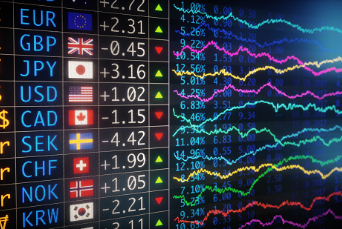
Charlie Brooks
May 07, 2022 16:22

The DeMarker indicator, or DeM, measures the demand for the underlying asset. Renowned technical analyst Thomas DeMark invented the indicator.
Oscillators were created to detect market manipulation. In strong trends, they will move in lockstep with the price, but they will not near the end of a trend. Divergences between the indicator and the price can be used to predict market tops and bottoms. Determining when to buy or sell an item can assist traders in entering a market.
The DeMarker indicator can be employed in a range of markets, including equities and FX. This blog post will teach you everything you need to know about the DeMarker indicator, spot probable trend changes, and use it in your everyday trading routine.
The Demarker indicator is an oscillator that identifies potential overbought and oversold market circumstances. As a member of the oscillator family of technical indicators, this instrument oscillates in a range between 0 and 100 throughout time (or 0.0 and 1.0).
Modern Market Wizard Tom Demark invented the Demarker technical indicator. The DeMarker indicator (also known as DeM) is an oscillator whose values are determined by comparing the highest and lowest prices of the current time period with those of the preceding time period. Based on this comparison, the indicator seeks to determine the market's directional bias. It simultaneously identifies overbought and oversold circumstances and seeks to determine trend exhaustion points based on these readings.
It is largely based on the theories of technical analyst Tom DeMark. However, the original indicator did not include any smoothing. As we shall see, the MetaTrader 4 version employs simple moving averages to smooth component values. Since the indicator is based on relative price data, it should be applicable to any time frame of interest, despite its initial design for daily price bars.
Tom Demark is a renowned trade expert who frequently appears as a guest on Bloomberg TV and CNBC. If that isn't sufficient, he was also a financial advisor for Steven A. Cohen of Point 72 Asset Management. Steven Cohen is likely one of the most successful hedge fund managers in existence today.
Paul Tudor Jones, the famed hedge fund manager who predicted the October 1987 market meltdown, was a previous client of Demark's.
Tom Demark indicators are renowned for their mechanically-driven design, which provides no opportunity for misunderstanding. Since the 1970s, Tom Demark indicators have been utilized on the stock market, futures market, fixed income market, and Forex currency market. Tom Demark's technical indicator, therefore, stands the test of time.
Tom DeMarker, the creator of the indicator, is a world-renowned technical analyst. He has developed numerous techniques for technical analysis, which are frequently utilized. Tom DeMarker created the DeMarker indicator after conducting market research. The DeMarker indicators reveal the market's desire for buying/selling, the loss of trend momentum, the instant the price reverses trend, and the level of risk when entering an order. This will boost the accuracy of the trader's decisions.
DeM contrasts the most recent maximum and minimum prices to the same values from the prior period. In essence, the indicator generates figures to help you determine the market's directional bias and potential trend reversals. DeMarker, unlike other oscillators, comprises a single fluctuating curve.
As a member of the oscillator family, DeMarker produces values between 0 and 1, while certain varieties of the indicator feature a 100 and -100 scale. Values closer to 0 indicate extreme oversold market conditions in the default configuration, whilst values closer to 1 indicate extreme overbought market conditions.
In this arrangement, which is MT4's default, the base value is 0.5, and the default time span for calculating values is 14 periods. By default, the overbought and oversold lines are set to 0.70 and 0.30, respectively. When the reading remains between these two levels, DeM shows that the market is likely trading in a range-bound manner and predicts a decrease in volatility. In contrast, excursions above 0.7 and below 0.3 indicate a trendier market. As the market trades in an extreme environment, the higher the likelihood of a price turn as the value approaches 0 or 1.
DeM functions similarly to the leading oscillator indicator, the Relative Strength Index (RSI). However, DeM emphasizes intra-period maximum recorded highs and lows as opposed to closing levels.
Values of DeMarker are computed using the following formula:
DEM = SMA(DeMMAX) + SMA(DeMMIN), where: DEM represents DeMarker
DeMMAX - tracks the difference between the current high and the prior high for X periods.
DeMMIN - tracks the difference between the current low and prior low over the number of X periods.
Before using the DeMarker indicator's signals in your regular trading routine, you may wish to trade using the MetaTrader 5 platform to familiarize yourself with the indicator and its optimal application.
Timing the market is crucial, especially in unpredictable situations. Large price fluctuations characterize volatile markets, so a timing indicator such as Demarker will provide you with an advantage in this type of situation.

The price's "effort" can be determined by comparing the price's speed to that of the Demarker oscillator indicator.
The right interpretation of this Demarker chart is straightforward. Expect a reversal if a substantial effort yields a negligible outcome. In other words, the price movement lacks bullish momentum if the Demarker oscillator line advances faster than the price. Therefore, smart money is not supporting this trend movement, and it is likely to reverse.
Expect a trend reversal if the outcome of this price movement is not equal to the amount of work expended.
DeMarker indicators are a common instrument employed by technical traders to time the market, but the logic for their use is not totally evident, nor is the selection of their parameters typically data-driven or justified. A recent study examined the efficacy of several DeM techniques for market timing using historical data from commodity futures markets. The first conclusion of this study is that the number of signals generated by DeM indicators is limited and infrequent. Compared to a simple buy-and-hold strategy, their findings indicate that the predictive effectiveness of the indicators is typically restricted to a narrow range of holding days.
Although DeM is touted as a strategy for timing trend reversals, substantial price swings that followed a signal did not reverse the existing trend in a number of instances. According to the authors of the research, "these results contradict the design of the indicator and make it difficult to comprehend its assumedly obvious economic logic."
As a combination, the DeM indicator should not be used alone; it may be more successful when combined with other technical indicators to corroborate or deny the signals it gives.
The DeMarker trading technique is a contrarian approach that seeks price reversals inside an established trend. Even while the indicator identifies overbought and oversold regions, they are not sufficient to forecast a reversal.
In general, overbought and oversold refer to abnormally high or low prices based on the sample data included in the lookback period. Rather than only indicating a reversal, the movement towards these locations may be indicative of the broader trend.
Strongly overbought indicates that purchasing pressure exists, and strongly oversold indicates the presence of selling pressure. How, therefore, may we utilize the overbought and oversold indicators to better comprehend market conditions? In order to determine whether the market is merely ranging, in a mild trend, or in a strong trend, we must first examine the length of time the market spends in overbought or oversold zones.
The length of time the market spends in overbought or oversold conditions reveals whether the market is trending or not. For instance, if a market is overbought for an extended period of time, this indicates that we are on an upswing.

If a market remains slightly overbought for an extended period — for example, above 50 but below 70 — this indicates a moderate rise. With the default number of 14 periods, we could conclude that levels above 70 indicate that the market is in a severe overbought area, and values below 30 suggest that the market is in extreme oversold territory.
As long as the indicator remains in these regions, we should be cautious about initiating a position, as it looks that directional pressure is in place. The optimal strategy is to buy temporary price decreases within an overall uptrend or sell temporary price spikes within an overall downtrend. This type of opportunity can be identified by watching for the indicator to move out of extreme overbought or oversold positions.
The smoother the DeMarker indicator curve, the greater the number of periods used. The greater the responsiveness of the curve, the fewer the number of periods. For shorter periods, which result in more pronounced oscillations, you may wish to consider a higher overbought threshold and a lower oversold boundary.
Similarly, with more considerable periods that produce shallower oscillations, you may wish to consider a lower overbought threshold and a higher oversold boundary. For instance, if you are utilizing a period value of 18, you may wish to consider 40 as oversold and 60 as overbought.
In spite of the fact that the DeMarker indicator provides us with some critical information about a market, it is prudent to consider additional information from a secondary indicator to verify what you are seeing. For instance, as seen in the preceding example, you may use a trend-confirmation indicator, such as a moving average, to double-check the market's condition. Indicators do not always examine the same data, and different indicators might provide a unique perspective on market data.
The DeMarker is essentially a contrarian technical indicator. As previously described, it identifies overbought and oversold market circumstances, indicating potential price direction changes.
Consequently, we are currently using the DeMarker indicator to identify potential price levels where a change in price direction may occur shortly. The USD/JPY is trading in a downtrend on the daily chart, as the price action has produced a succession of lower highs and lower lows.
As previously stated, DeM is most effective when used in combination with other technical indicators. As a result, we employ Fibonacci extensions to find support levels where sellers may reach a stalemate, giving buyers an opportunity to drive the price movement higher.
The blue arrow indicates the instant the price action reaches the Fibonacci extension support at 127.2 percent, indicating that buyers are likely to enter the market and drive the price higher. In addition, sellers are likely to exit their profitable positions at this time.
The market has reached oversold territory, as shown by DeMarker's reading of 0.277. The market is oversold, according to DeMarker, and the price action has reached the first Fibonacci extension support.
Consequently, this technique is predicated on employing other indicators in conjunction with DeMarker to identify potential price action reversal zones.
Entry should be set at the point when 127.2 percent is first struck, while stop-loss should be positioned approximately 40 to 50 pips below this level to guard against whipsaw losses located by knee-jerk market movements.
The profit target is established at the beginning of the Fibonacci extension or where the significant horizontal support is located. Prior to the bears erasing all gains and pushing price action below this crucial support level, the market had begun to go higher from this position.
Our hypothesis is that the market will return to the "crime scene" and retest the same level, but this time in the context of resistance. Eventually, this will occur, and our trade will be concluded. We were able to earn approximately 200 pips while risking no more than 50 pips, and this risk-to-reward ratio is exceptional. This example illustrates how DeMarker can be combined with other technical tools.
It is quick and simple to configure the DeM in MT4. Follow the below steps.
Go to the primary menu. Click Insert, followed by Indicators, and finally Oscillators.
Next, click DeMarker. A dialog box with tabs labeled. Parameters, Levels, Scales, and Visualization will appear.
Under Parameters, the default term is 14 days. Adapt it as you see fit.
Navigate to the Scale tab next.
There is the ability to set any minimum and maximum value. We propose entering "0" and "1" and checking the "fixed minimum" and "fixed maximum" boxes.
This will display the indicator with 1 at the top and 0 at the bottom on your chart. There are dashed lines at 0.30 and 0.70.
You are now prepared to utilize the DeM in Forex trading.
Try changing the settings. You can alter the minimum and maximum values for this indicator and the overbought and oversold lines. If you have a small number of periods, you may choose to expand these.

Check for verification. The DeMarker indicator used in isolation is insufficient for a functional system, and you should combine it with an additional indicator or price action to achieve confluence. In fact, you might utilize it to provide context, with price patterns or other indicators serving as your setups.
Examine your system. Before risking real money on live Forex trades, it is necessary to backtest and demo test your trading technique, regardless of the settings you choose for this indicator and the trading approach you employ.
The DeMarker indicator is a momentum oscillator with more than one trick up its sleeve, as we have seen. You can use the indicator to determine whether a market is trending or not. If you have recognized a market trend, the indicator will validate the market's overall inclination. Day traders do not widely use the DeMarker indicator, but the vast majority of professional traders employ it. It is a simple-to-use indicator applicable to stocks, currencies, and cryptocurrencies, among other assets. The indicator also provides values for buying and selling pressure, which is particularly valuable. With the use of these signs, we may utilize the DeMarker indicator to identify potential transitory price trend reversals.
The DeMarker indicator, or DeM, is a technical indicator used by traders to evaluate the underlying asset's demand. As an oscillator, it creates values between 0 and 1, where values of 0.7 or higher indicate an overbought market and readings of 0.3 or below indicate an oversold market and impending price direction change.
DeM is intended to compare the most current maximum and minimum prices to the corresponding price from the preceding period. DeMarker assists you in identifying the market's directional bias and potential shifts in trend direction. As with other technical indicators, it is most useful when used in combination with other tools.

May 05, 2022 14:44

May 07, 2022 17:18